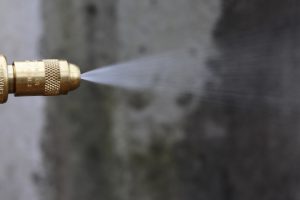Spray Coverage Vs. Spray Coverage: Aquatic Herbicide Applications
Insufficient herbicide spray coverage can result in poor weed control requiring repeated applications and increased management costs. All too often we hear you need “good coverage” when spraying herbicides for the control of invasive plants. While this suggestion is generally true in any application, it is important to understand there are two different types of spray coverage to consider. The difference between the two are simply dependent on the scale of concern. Think of this as the magnification setting of your microscope whether you are wanting to see the number of leaves on a plant or the number cells in a leaf.

Spray Coverage Type I
The first spray coverage type is similar to counting the number of cells per leaf in the microscope analogy. This coverage is focused on a small scale (square inches or centimeters) looking at the proportion of target plant surface area that received spray droplets and compared to surface area not in contact with a spray droplet. Small scale spray coverage is what is optimized in an agronomic pesticide application and does not necessarily need to be 100%. In fact, recent research at the UF/IFAS CAIP suggests some herbicides perform similarly, if not more effectively, when application parameters are adjusted. This performance results in small scale spray coverage of 30 to 60% compared to 100%. However, that is a discussion for another time.
Spray Coverage Type II
The second type of spray coverage is on a large scale (square feet or acres), similar to counting the number of leaves per plant in the microscope analogy. This is also the type of spray coverage most applicators are concerned about, for good reason. Large scale spray coverage can be defined as the proportion of the target area that received herbicide verses the proportion of the target area that was missed. In every application this type of coverage should always be 100%. Any deviation from 100% large scale spray coverage results in plants that are left untreated and therefore unmanaged.
Large scale spray coverage is not usually considered in most terrestrial applications utilizing broadcast booms, as 100% of the target area is always covered by the application. However, most foliar aquatic applications utilize a single-nozzle handgun which relies on the applicator to oscillate the spray pattern back and forth by hand. Consequently, relying on human mechanics compared to mechanized systems can result in inconsistencies in large scale spray coverage. Furthermore, these applications are commonly conducted by airboat without the use of rate controllers, GPS, or nice straight rows of crops to keep us on track.
Written by Dr. Benjamin P. Sperry, UF/IFAS CAIP Research Assistant Scientist. For more information about the UF/IFAS Center for Aquatic and Invasive Plants, please visit http://plants.ifas.ufl.edu. Be sure to follow us on social @UFIFASCAIP. To read more blogs like this one visit https://blogs.ifas.ufl.edu/caip/.
 0
0
